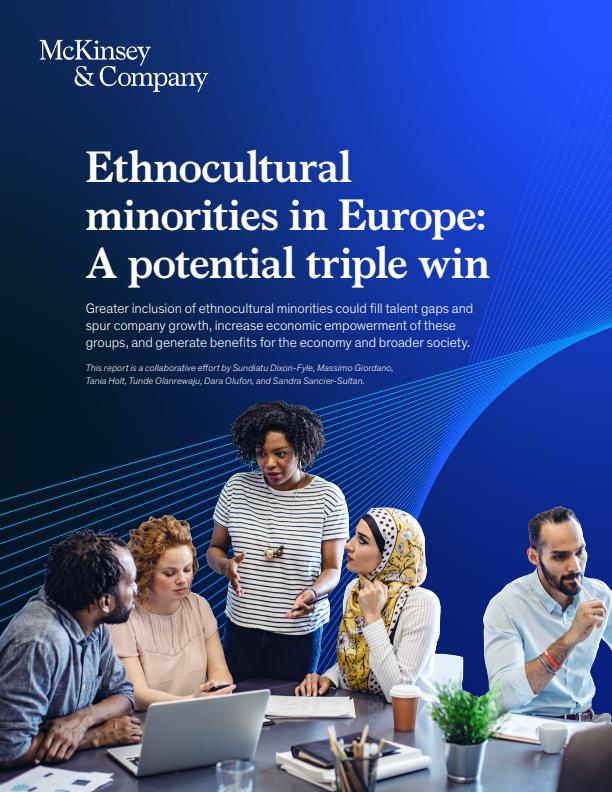As Europe-based companies tackle the challenges of slowing economies and tight labor markets, pursuing new levers for sustainable, inclusive growth has become an imperative. As our recent research on accelerating Europe’s competitiveness highlights, Europe is a global leader on inclusion outcomes such as income inequality, social mobility, and social progress.1 But there is scope to go further in pursuing growth while extending the benefits of inclusivity across communities. This includes strengthening economic inclusion of ethnocultural minority communities as a source of talent to deliver inclusive growth.
Ethnocultural minorities represent a diverse group within the European population and a workforce that is not well understood. The opportunities they present, particularly in terms of talent, have remained largely unexplored by the business world. Several factors contribute to this, the most significant being the lack of a fact base across European countries. This stands in the way of understanding the extent to which, and how, ethnocultural minority employees (EMEs) can be better identified, recruited, and supported to address the talent gaps affecting growth in economies across the continent.
Our new research, previewed recently,2 sheds light on ethnocultural minorities and their experiences in the workplace (see sidebar, “About the research”). We find that ethnocultural minorities constitute a meaningful share of the population across Western European markets, with significant nuances across countries in terms of region of origin, educational attainment, labor market and socioeconomic outcomes, and workplace experiences. Additionally, companies’ approaches toward EMEs in Europe indicate that inclusion initiatives are beginning to gain traction within diversity, equity, and inclusion (DEI) strategies, and that emerging best practices could help companies chart a path forward.
Strengthening EME inclusion in the workplace would enable a triple win: it would spur company growth by addressing talent gaps, boost economic empowerment of EMEs and their families, and deliver benefits for the economy and wider society in terms of economic inclusion and social cohesion. Our analysis shows the potential opportunity is significant—contributing almost €120 billion to GDP annually—providing companies with a clear incentive to act.
Labor shortages are projected to persist—and ethnocultural minorities could help address them
European companies are facing a significant shortfall in skilled workers. According to recent data from the European Union, 29 countries in Europe are experiencing talent shortages.3 The EU job vacancy rate has increased by approximately 70 percent since 2020,4 with labor shortages particularly prevalent in occupations related to software development, healthcare, social work, construction, and engineering.5
Business leaders predict that labor shortages will continue to be one of the top three barriers to business growth over the next year.6 Both short- and long-term trends, such as falling labor force participation during the pandemic and the impact of an aging population, have exacerbated the problem. In most occupations, shortages have persisted for more than five years, suggesting that underlying structural issues play a major role. These issues will likely persist for the foreseeable future, framing the opportunity for greater inclusion of EMEs in the workplace.
Ethnocultural minorities account for a meaningful share of the national population in most Western European countries—ranging from 5 to 18 percent, with an average of 10 percent (Exhibit 1).7 Their regions of origin vary markedly across Western Europe. For example, the largest ethnocultural minority population overall came from Asia, while the Middle East and North Africa (MENA) is the largest region of origin for countries such as France and Belgium. In Germany, the second-largest group originates from Türkiye, reflecting well-known historical migration patterns.

An important starting point for European companies seeking insight into the workplace potential of EMEs is to understand the scale, composition, and educational attainment of ethnocultural minority populations, and how these vary across the region. This perspective is particularly relevant for large companies operating in multiple markets across the continent, which need to understand the nuances of talent supply and demand at a local level to avoid a one-size-fits-all approach.
Ethnocultural minorities experience worse labor market outcomes despite comparable levels of tertiary education
Another challenge in unlocking the economic potential of ethnocultural minorities stems from a common misperception that they lack the necessary skills to be qualified job candidates. The data suggests otherwise, painting a more nuanced picture.
Ethnocultural minorities span the full spectrum of educational attainment, including at the tertiary level
Our analysis of six countries found that the level of tertiary educational attainment for ethnocultural minorities ranges from 24 to 44 percent (Exhibit 2). On average, this rate is below that of the nonminority population, but the gap is relatively small (three to nine percentage points), and there are notable exceptions: in Denmark, for example, the tertiary completion rate for ethnocultural minorities is 44 percent, nine percentage points higher than that of the nonminority population (35 percent), while in Belgium it is 32 percent, five percentage points higher than that of the nonminority population (27 percent).

At the other end of the educational-attainment spectrum, ethnocultural minority populations are also less likely than the nonminority population to have advanced beyond lower secondary education. In some countries, the gaps are large—for example, ethnocultural minority individuals in Germany are about three and a half times more likely than their nonminority peers to have lower levels of educational attainment.
EMEs are more likely to be overqualified for their jobs
We assessed overqualification rates using the most granular data available: OECD data of first-generation immigrants who were born in Africa, Asia, or Latin America but have jobs in their current country of residence. Individuals were considered overqualified if they had tertiary education or above but held jobs that were categorized as low or medium skill by the International Standard Classification of Occupations (ISCO) classifications 4–9.8 Compared with nonminority employees, EMEs are up to three times more likely to perform low-skill jobs and up to two and a half times as likely to be overqualified for their current role (Exhibit 3). For example, in Denmark, EMEs are 11 percentage points more likely to be overqualified compared with their nonminority counterparts, while in Belgium they are six percentage points more likely to be overqualified.

These overqualification rates suggest that barriers to the full participation of highly qualified EMEs in the labor market—including the perception of EMEs as less qualified as well as constraints linked to recognition of international qualifications, language barriers, or both—may be obscuring their potential. We explore some of these factors in a new employee experience survey that we report on below.
Ethnocultural minority populations face further adverse labor market outcomes. Across all educational groups, they are more likely to be unemployed or out of the labor market in each of the six countries in this analysis—Belgium, Denmark, France, Germany, Italy, and the Netherlands. For example, EMEs are up to four times more likely to be unemployed than their nonminority peers, and their labor participation rate is ten to 18 percentage points lower than that of nonminority individuals in France and 13 percentage points lower in Denmark. This suggests that the challenges faced by EMEs in the labor market extend beyond matching jobs to qualifications—all EMEs seem to face barriers accessing employment in general, and this may be driving adverse social outcomes, as we explore in the next section.
Ethnocultural minorities face adverse socioeconomic outcomes
As a likely consequence of worse outcomes in the labor market, ethnocultural minorities fare notably worse in terms of income and poverty compared with nonminority individuals.9 Across the six countries in this analysis, we found that ethnocultural minorities earn lower salaries. In Germany, they are half as likely to be in the top income bracket as nonminority individuals, and in Denmark, their salaries are up to nine percentage points lower. Although Italy has less granular data, the salary of its foreign nationals is 20 percent lower than that of Italians, on average.
These gaps translate into higher rates of deprivation. In France, for example, ethnocultural minority individuals are 2.5 to 3.5 times more likely to live in poverty than nonminority individuals. These patterns hold across Europe: Eurostat data from 2022 shows that individuals born outside the European Union were more likely to face poverty (2.8 times) and material and social deprivation (1.9 times) compared with the population as a whole.10
Improving labor force participation and employment outcomes for ethnocultural minorities would not only increase household incomes but also help companies address talent gaps and spur company growth. At the same time, it would deliver socioeconomic benefits including economic growth and greater social cohesion—a triple win.
EMEs face mostly challenging experiences in the workplace
To better understand the experience of EMEs in the workplace, we conducted a survey of nearly 4,000 employees at publicly traded companies across five countries,11 including approximately 1,700 respondents who self-identified as EMEs. Our findings highlight the disparities EMEs face and surface some of the causes of these challenges (Exhibit 4).

EMEs experience barriers both in accessing jobs and within the workplace
Our survey of employees about their experiences within the workplace reveal that the overall picture for EMEs is challenging, with many reporting barriers to getting a job, advancing, and feeling included. This situation is coupled with, and is a potential cause for, EMEs being more likely to want to leave their current role.
For example, EMEs were about twice as likely to report barriers to securing the right employment opportunities, with the most-cited obstacle being discrimination based on cultural background (22 percentage points higher than for nonminority employees). Fifty-four percent of EME respondents reported that they had missed out on a career advancement opportunity such as a raise or promotion—nearly twice the rate of nonminority employees—with their ethnic background being the second-most-cited barrier.
EMEs were about two and a half times more likely to say they experienced biased behavior and microaggressions on the job (for example, being confused for someone else of the same ethnicity or enduring negative comments about their background) compared with nonminority employees. They were also nearly two times more likely than their nonminority counterparts to report that they intend to resign from their current position within the year.
These reported experiences in the workplace help shed light on the labor market and socioeconomic outcomes for EMEs described above, and point to an opportunity for employers to do more to hire, retain, and advance EME talent. Understanding how these experiences vary among EMEs can help companies better tailor supportive interventions—as we explore in the next section.
The ethnocultural minority experience is not homogeneous, with nuances based on occupational skill level and educational attainment
In seeking to understand how EME experiences may vary, we analyzed survey responses by both occupation skill level and educational level. Reported experiences varied along both these dimensions.
Perhaps unsurprisingly, EMEs in low-skill occupations, at all educational levels,12 were the most likely to report challenges relating to all aspects of the workplace. Relative to EMEs in high-skill occupations, they were 37 percentage points more likely to report barriers to employment, and they were 24 percentage points more likely to report missing out on advancement opportunities. They also reported facing more barriers to employment and advancement opportunities than did nonminority employees in similarly low-skill occupations.
Meanwhile, reported challenges, such as those related to career support and advancement, also vary by level of educational attainment.13 EMEs with lower levels of attainment were less likely to report receiving mentorship support in the workplace than EMEs with high attainment levels. A similar pattern emerged regarding training. This suggests there could be an opportunity to provide more-effective support and training for low-attainment EMEs, closing the gap versus high-attainment EMEs.
While EMEs in high-skill occupations reported fewer challenges than those in low-skill occupations, they still experience more challenges than all nonminorities, irrespective of occupational skill level. These challenges include barriers to employment (57 percent compared to 44 percent), likelihood of experiencing bias (71 percent compared to 55 percent), and intention to resign from their job within the year (36 percent compared to 32 percent).
There were some bright spots. For example, EMEs with higher levels of educational attainment reported benefiting from company inclusion programs and were more likely than nonminorities to report receiving training and professional development initiatives (80 percent for EMEs compared with 56 percent of their nonminority counterparts). However, these benefits were not yet translating into concrete outcomes: 55 percent of high-attainment EMEs reported being likely to miss out on advancement opportunities, versus 33 percent of their nonminority counterparts. And this does not appear to be linked to ambition: EMEs with high educational attainment were slightly more likely than their nonminority counterparts to express interest in seeking advancement to the executive level (65 percent for high-attainment EMEs compared with 57 percent).
The above findings suggest that companies are starting to provide support for EME inclusion in the workplace, but that they also have real opportunities to go further. For example, they can start to understand the challenges faced by different segments of their EME workforce to offer targeted and more-effective career development training, implement mentorship and sponsorship programs to improve career progression, and establish an inclusive workplace culture that tackles biases and microaggressions.
EME inclusion presents a sizable opportunity, and companies are beginning to engage
How can companies think about the potential value of this EME inclusion opportunity? We estimate that companies hiring EMEs to address skills gaps could contribute an additional €120 billion to EU-27 GDP a year, a 4 percent increase over the 2022 figure. Of this total, approximately €50 billion would be company profits, with the balance in wages.14
If these figures were achieved, organizations would fill approximately one-quarter of job openings in Europe across all occupational skill levels, employing an additional 1.6 million people. The true value to economies is likely to be higher, as this estimate is based on closing the employment gap between ethnocultural minority and nonminority employees. It does not factor in other potential economic benefits, such as increased consumption resulting from rising EME incomes, or the noneconomic benefits of greater diversity in the workplace.15
Having considered labor market and socioeconomic outcomes and the experiences of EMEs in the workplace, as well as the potential growth impact from companies hiring more EMEs, we next turn to understanding how companies are today thinking about tackling this issue.
To deepen our insights into EME inclusion practices in the workplace, we researched companies through two lenses: an outside-in analysis and interviews with senior officers.16 The outside-in analysis examined 30 of the largest companies in each of our five surveyed countries to assess their EME representation in leadership, publicly reported initiatives, and commitments to EME inclusion. The analysis was based on publicly available information from company websites; annual reports; environmental, social, and governance reports; and DEI reports. We also conducted 21 interviews with chief human resources officers, chief diversity officers, and external experts (including 14 representatives of companies based in continental Europe) to better understand EME inclusion initiatives, challenges faced, and emerging best practices.
Our outside-in analysis showed that both executive teams and supervisory boards tend to have fewer people from diverse regions of origin17 than in the population, albeit somewhat less so for boards. While the share of ethnocultural minorities in the population of countries analyzed was about 11 percent, just 6 percent of those on executive boards were from a diverse region of origin. One-third of the 150 companies we analyzed have at least one individual from a diverse region of origin on their executive teams, and almost half (45 percent) have at least one such individual on their boards.
To understand an organization’s DEI practices, we typically consider its actions across five dimensions. As applied to EMEs, these dimensions are: EME inclusion strategy, data on ethnocultural representation and inclusion, EME talent and inclusion initiatives, governance of EME inclusion, and external engagement on EMEs (Exhibit 5).18 We used this framework to complement our outside-in research with insights from the aforementioned interviews. While the findings are indicative, they highlight some encouraging signs of progress:
- EME strategy. More than one-quarter of the companies analyzed reported that they include ethnocultural diversity as a strategic focus of their global DEI strategy, and the majority of companies interviewed reported the same.
- Ethnocultural data. Almost half (45 percent) of the 150 companies publish data on representation by nationality within their DEI reports. Among the companies we interviewed, two had started tracking EME inclusion through self-reporting.
- EME inclusion initiatives. Companies are beginning to implement initiatives to support EMEs. For example, 14 of the 150 companies analyzed explicitly mentioned establishing employee resource groups for EMEs in continental Europe, and another seven companies described existing or planned initiatives in this area. Among the 14 continental Europe–based companies interviewed, two highlighted that they actively recruit EMEs in areas experiencing significant talent shortages.
- Governance of EME inclusion. Dedicated structures and processes to support EME inclusion tended to emerge in companies that already have well-established DEI governance structures. A few company representatives we interviewed said they had begun to appoint sponsors, dedicate resources, and extend DEI accountability processes to EME inclusion.
- External engagement on EMEs. This was mostly at an early stage, with two company representatives telling us that they have begun reaching out to peers within or outside their industry sector to share knowledge and best practices on EME inclusion. A handful mentioned investing in deepening the EME educational talent pipeline through upskilling initiatives (largely within their social impact efforts or in collaboration with the not-for-profit sector). Six companies had started engaging with third parties, such as EU diversity chapters, on best practices.

Our research highlights that increasing commitment and engagement could help companies unlock the potential of ethnocultural minority employees within the European workforce. There is a compelling business case for doing so, as it could deliver significant benefits for companies, EMEs and their families, and European economies at large through greater economic inclusion and social cohesion—a triple win delivering inclusive growth.
Companies can start by developing a robust understanding of the strategic and talent-centered challenges they face and assess whether greater inclusion of EMEs could help address them. This includes gathering data on their current EME representation and inclusion; understanding the skills and educational attainment levels of the EMEs in the markets in which they operate; developing initiatives to address talent gaps; and creating talent processes and work environments that support the ability of EMEs to thrive and further their careers. Company leaders have a critical role to play in taking ownership of this agenda and rallying their companies in overcoming the cultural and practical barriers to delivering on it.
We hope this report will stimulate ongoing dialogue on how companies in Europe can more purposefully engage with DEI for ethnocultural minorities as a means to drive their own growth, empower employees, and uplift the economies and communities in which they operate.







